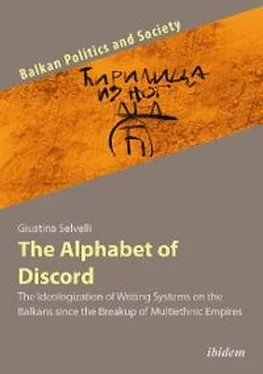The combination of two or more letters to represent a single phoneme is generally considered, especially from a Cyrillic perspective, to be one of the major shortcomings of the Latin-based writing system (Wellish 1978: 47); in the case of the Abecedar , this element is certainly not the most important problem, as the obstacles to literacy in the Slavic-speaking community emerge in much more significant imperfections appearing in the text. In his review, Miletich cites a long series of examples from the pages of the primer in which words appear to be spelled incoherently, and notes that these inaccuracies represent a clear act of outrage by the Greeks against the Bulgarian script (Miletich 1925: 232).
It appears that the authors of the Abecedar did not pay too much attention to details and neglected the correct use of the writing system they had developed, probably due to a lack of time and attention, but perhaps also, one could assume, due to their own inability to handle a Latin alphabet they had not mastered very well. In this way, they undermined their own linguistic work and jeopardized the possibility of success for the use of the new alphabet by the target population, if that was indeed the goal of their efforts. According to Fishman (1977: xv), the creation of a new script becomes relevant only “insofar as it leads to the acceptance and implementation of the writing systems.” In our case, the decisions that taken in the Abecedar seem rather to indicate of a lack of will and seriousness in planning alphabet reform.
2.6 The “involvement” of Cyril and Methodius
As mentioned above, the use of the Latin instead of the Cyrillic alphabet provoked strong reactions in the Bulgarian press. In fact, once more precise information about the “character and tendencies of this primer” (Shishmanov 1926: 2) was released, anger seized all social circles, without distinction (ibid.). It is interesting to remark that the Greek authorities, in defending their choice, argued that Latin characters were easier to learn than Cyrillic and better suited to the sounds of the language; they recalled that Latin characters had already been used for writing other Slavic languages such as Croatian, Polish and Czech and that, by using some specific diacritical marks, they were able to make the most of the specific phonology of Slavic languages (Michailidis 1996: 339). It is clear that this comparison is accurate from a purely technical and linguistic point of view, but not from a cultural and historical one, since the Slavic peoples mentioned belong to the Catholic sphere of influence and, for them, unlike for the people of the Orthodox faith, the Cyrillic alphabet had no symbolic meaning.
In discussing the phenomenon of the creation of new writing systems, it is essential to evaluate the importance of some extralinguistic factors (Fishman 1977: xii): the application of a writing system to a language is impossible without the imposition of conventions that are accepted as binding by virtually all those who read and write that language (Wellish 1978: 41). In this case, the will of the people was certainly not taken into account in the choice of a Latin-based alphabet. It was not so much a question of abandoning fidelity to previous writing conventions, since the majority of the population were illiterate, but rather of breaking the bond with the Cyrillic alphabet of the liturgical books and icons in the local churches: that is, with the Orthodox religious tradition.
The Bulgarian and Greek governments, as well as the government of the Kingdom of Serbs, Croats and Slovenes, were all aware of the “power of writing,” that is, of the fact that writing, and therefore literacy, would have a great impact on the speakers of a language and their society (Biscaldi, Matera 2016: 91). They also knew that the conventions of writing systems were inherently sacred and that one writing system could only be replaced by another by force (cf. Wellish 1978: 42). In Bulgaria, the concern about alphabet reform in Latin letters for the Slavophone population in Greece was linked to the belief that this would represent a disruption in the cultural and religious tradition inaugurated by Saints Cyril and Methodius, and this would have extremely significant consequences for this minority’s identity. This was also the immediate reaction of the local Slavic population to the news of the publication of the primer in Latin characters, who exclaimed: “Are they also going to make us Catholics now?” (Kuševski 1983: 186)—a reaction which shows that use of the Latin alphabet was automatically associated with the Catholic sphere of influence.
In Bulgaria, on the news of the publication of the primer for the Macedonian Bulgarians, the philologist Miletich bitterly commented that it was not written “with their centuries-old Cyrillic alphabet, which they gave to the Slavic world through the Cyrillo-Methodian script, but with a kind of Latin alphabet” (Miletich 1925: 230; my translation). Moreover, Miletich criticized the very definition of Abecedar, which was in itself controversial: “The primer is called ‘Abecedar,’ a name that the Bulgarian population would hardly understand, since it is derived from the first letters of the Latin alphabet.” According to Miletich, the Greek government treated its Bulgarian subjects as “a new nation, a recently discovered one, without legitimacy, without its own writing and literacy, without its own literary tradition and standardized literary language” (Miletich 1925: 230; my translation).
In his text, the philologist Shishmanov addressed the Greek Ministry of Education and demanded an explanation for choosing the Latin alphabet for the Slavic people living on Greek territory. Since the Ministry recognized the existence of this minority, he wondered, was it not necessary to retain the Cyrillic script used by this population in all their “many and thriving” schools, whose existence preceded the Greek occupation? Shishmanov also insisted, much like Miletich, on the fact that the Slavic alphabet (referring in his case to the Glagolitic alphabet, not the Cyrillic) was, “as commonly known, created by the brothers Cyril and Methodius on the model of the Greek script.” He explained that the Greek authorities’ choice in 1925 was provoked by the strong fear on the part of Greek institutions of Bulgarian cultural—and hence political—influence. Consequently, the minority population was deprived of the possibility of reading books and newspapers printed in Cyrillic letters in Bulgaria, and was materially and symbolically isolated from its most “natural” context of reference. Shishmanov also raised a very practical question, wondering what would happen to the Slavic liturgical books if the Greeks were really to force the Slavophone minorities to use the Latin alphabet for education:
Must these also be translated into the Bitola-Prilep dialect and printed in Latin letters? And from where will “Slavic” priests be taken henceforth who know how to use the Latin alphabet? These disturbing questions have not been answered by the official Greek authorities because they have not thought about these implications at all. They knew very well that in the end it was a simple “bluff.” (Shishmanov 1926:14; my translation)
In the Bulgarian national conception of which both Miletich and Shishmanov were representatives, the population of Aegean Macedonia was seen as dependent on the Bulgarian cultural and religious sphere and therefore inseparable from the Cyrillic alphabet (see Tramontano 1999: 323). According to a vision associated with the Slavic Orthodox cultural tradition, indeed, writing exercised a function far beyond the mere graphic representation of phonemes, since alphabet and faith were intimately connected. This is not an exclusive feature of Slavic Orthodox culture, for in other Eastern Christian traditions, as well as in the Islamic world (and also beyond), the value of the written word is also extremely strong (see Cardona 2009b: 133), especially when it occurs in a form perceived as “native.” So, in addition to the Glagolitic alphabet for Bulgarians and Croats (as we will see in Chapters 7 and 10), the Cyrillic alphabet for Bulgarians, Serbs, Russians, etc., we also have the examples of the Armenian alphabet for Armenian communities worldwide (associated with the Armenian Apostolic Church; see, for example, Maksoudian 2006, Uluhogian 1996), the Georgian alphabet (see Gamkrelidze 1994) for Georgians, as well as the Ge’ez alphabet for Ethiopians and Eritreans (see Cardona 1986: 151) and their respective Tewahedo Orthodox Churches (see Bekerie 1997).
Читать дальше












